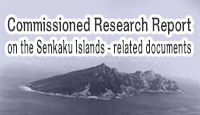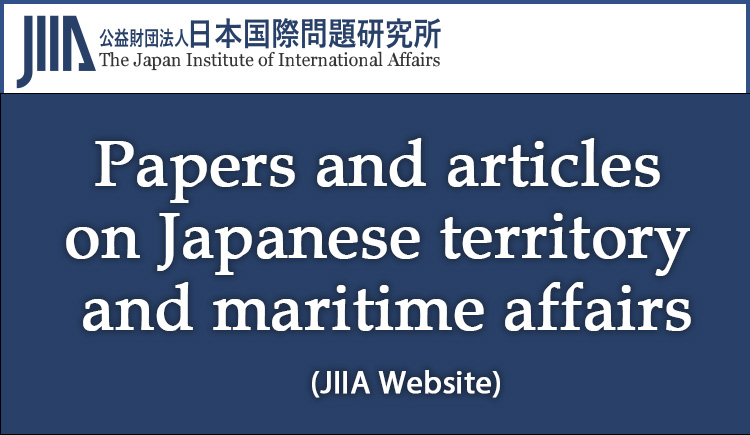The documents and materials published on this website were collected, researched, and prepared with advice from experts, as a part of a Government-commissioned project. The contents of this website do not reflect the views of the Government. Links to external sites (domains other than https://www.cas.go.jp) are not under the management of this site. For linked websites, please check with the organization/group that manages the website for the link in question.
Comprehensive issues
Column The Senkaku Islands, Takeshima and International Adjudication
Kazuhiro Nakatani (Professor, Graduated Schools for Law and Politics, The University of Tokyo)
*Adobe Acrobat Reader DC, provided by Adobe, is needed to view the PDF files. If you do not have the software, please download it from the linked site. Adobe Acrobat Reader DC
1. Introductory Remarks
This short essay considers the following highly hypothetical question: what decisions reasonable judges would make if they have opportunities to consider the merits of the Senkaku Islands and the Takeshima cases at the International Court of Justice (ICJ) ?
2. The Merits of Senkaku Islands Case
As there exist no jurisdictional basis for international adjudication and no dispute involving the Senkaku Islands, it is highly hypothetical that the ICJ would have an opportunity to decide on the merits of the case1. Having said that, decisions that ICJ judges would be likely to make on the merits of the Senkaku Islands case based on the orthodox interpretation and application of international law could be summarized as follows.
In January 1895, Japan, having ascertained that the Senkaku Islands were terra nullius and there had been no trace of control over them by other States, incorporated them into Okinawa Prefecture by issuing a cabinet decision. As the PCIJ states in its Judgment of the Legal Status of Eastern Greenland case, “the intention and will to act as sovereign” and “the display or effective exercise of such authority” are the two requirements for a territorial claim2. Japan’s occupation over the uninhabited Senkaku Islands and its effective, continuous and peaceful control over the Islands satisfy these two requirements.
Although Japan did not inform other States of the incorporation of the Senkaku Islands in 1895, the notification is not required under general international law unless otherwise provided by a specifictreaty. The arbitral award of the Clipperton Island case (1931) states: “La régularité de l’occupation française a aussi été mise en doute parce qu’elle n’a pas été notifiée aux autres Puissances. Mais il faut observer que l’obligation précise de cette notification a été stipulée par l’art. 34 de l’acte de Berlin précité, qui, comme il a été dit plus haut, n’est pas appliquable au cas présent. Il y a lieu d’estimer que la notoriété donnée d'une façon quelconque à l'acte suffisait alors et la France a provoqué cette notoriété en publiant l’acte même de la manière sus-indiquée.”3 This Cabinet decision was totally unrelated to the Sino-Japanese war. The decision was made before the signature of the Shimonoseki Peace Treaty of April 1895, and the Senkaku Islands were not included in Taiwan and its affiliated islands that were ceded to Japan under the Treaty.
China has not proved persuasively that the Senkaku Islands were not terra nullius. In international law the mere discovery of an island is only an inchoate title, as was pointed out by the arbitral award of the Island of Palmas case4. Maps have only limited probative value. The ICJ, in the Burkina Faso/Mali Frontier Dispute case (1986), states: “maps merely constitute information which varies in accuracy from case to case: of themselves, and by virtue solely of their existence, they cannot constitute territorial title, that is, a document endowed by international law with intrinsic legal force for the purpose of establishing territorial rights.”5
China had never lodged protests with Japan and had asserted no territorial title to the Senkaku Islands for as long as 75 years from 1895, when Japan incorporated the Senkaku Islands into Okinawa Prefecture, to approximately 1970. After the United Nations Economic Commission for Asia and the Far East (ECAFE) indicated the possibility of the existence of petroleum in the East China Sea in Autumn 1968, China and Taiwan suddenly began making their assertions about the Senkaku Islands. China’s silence for as long as three quarters of a century clearly constitutes acquiescence under international law. As pointed out in the ICJ decision on The Temple of Preah Vihear case (1962), qui tacet consentire videtur si loqui debuisset ac potuisset.6 Moreover, the Republic of China’s Consul in Nagasaki Prefecture writes “the Senkaku Islands, Yaeyama-gun, Okinawa Prefecture, the Empire of Japan” in his letter expressing gratitude addressed to the Japanese who saved a group of shipwrecked Chinese fishermen in May 1920. And on 8 January 1953 the Chinese State newspaper People’s Daily wrote clearly that “the Senkaku Islands were included in the Ryukyu Islands.” These facts clearly indicate China’s admission that the Senkaku Islands belong to Japan. China’s assertion of title to the Senkaku Islands not only lacks grounds in international law, but also is precluded by the principle of estoppel.
Note 1
If China would like to submit the Senkaku Islands case to the ICJ, it can do so by accepting the compulsory jurisdiction of the ICJ, as Japan has done since 1958, and then by suing Japan. Even so, Japan might assert that there exists no dispute concerning the Senkaku Islands as a preliminary objection. It pertains to the discretion of the ICJ whether this objection is decided at stage of the preliminary objections or is joined to the merits.
Note 2
PCIJ Ser.A/B, No. 53, pp. 45-46.
Note 3
Reports of International Arbitral Awards, vol. II, p. 1110.
The unofficial English translation (by the present writer) is as follows: “The legality of the French occupation has also been called into question because it has not been notified to the other Powers. But it should be noted that the specific obligation of this notification has been provided by Art. 34 of the Berlin Act, which, as noted above, is not applicable in the present case. There is reason to believe that the publicity given to the Act in any way was sufficient and France made public the occupation by publishing the Act in the manner indicated above.”
Note 4
Reports of International Arbitral Awards, vol. II, p. 846.
Note 5
ICJ Reports 1986, p. 582.
Note 6
ICJ Reports 1962, p. 23.
The Latin phrase means that the State which remains silent when it should have and could have objected is considered to have consented.
3. The Merits of the Takeshima Case
Japan proposed to Korea that the Takeshima dispute be submitted to the ICJ on three occasions (September 1954, March 1962 and August 2012). Those proposals were, however, refused by Korea. The decisions that the ICJ judges are likely to make on the merits of the Takeshima case based on the orthodox interpretation and application of international law could be summarized as follows.
Japan, having been aware of the presence of Takeshima for a long time, established its territorial title to the island by the middle of the 17th century. With a Cabinet decision of 28 January 1905, Japan reconfirmed its sovereignty over Takeshima and incorporated it into Shimane Prefecture. This Cabinet decision has nothing to do with the Japan-Korea Treaty of November 1905 and the Japan-Korea Treaty of August 1910. Following the Cabinet decision, Japan allowed licensees to catch sea lions on and around Takeshima and continued the license program until it was ceased in 1941 due to World War II. Japan kept effective control over Takeshima as its sovereign and displayed its sovereignty continuously and peacefully. The renowned Arbitral Award on the Island of Palmas case (1928) states that “continuous and peaceful display of the functions of State within a given region is a constituent element of territorial sovereignty.”7 In view of this criterion, Japan’s sovereignty of Takeshima has been firmly established under international law.
Under Article 2 (a) of the San Francisco Peace Treaty with Japan (1951), “Japan, recognizing the independence of Korea, renounces all right, title, and claim to Korea, including the islands of Quelpart, Port Hamilton and Dagelet.” However, “Korea,” which Japan renounced under the said provision, does not include Takeshima. On 10 August 1951, just one month before the signature of the Peace Treaty, Dean Rusk, U.S. Assistant Secretary of State for Far Eastern Affairs, replied clearly to Yang Yu Chan, Korean Ambassador to the United States as follows: “As regards to the island of Dokdo, otherwise known as Takeshima or Liancourt Rocks, this normally uninhabited rock formation was according to our information never treated as part of Korea and, since about 1905, has been under the jurisdiction of the Oki Islands Branch Office of Shimane Prefecture of Japan. The island does not appear ever before to have been claimed by Korea.8 The interpretation of the said provision of the Treaty by the United States, the party which played a central role in drafting the treaty, has much probative value.
Moreover, under general international law, renunciation is not presumed and the extent of renunciation, even in cases lacking clarity, has to be interpreted in a narrow sense in favour of the renouncing State. The Arbitral Award of the Affaire Campbell (1931) states: “Attendu qu’il est de principe, admis par le droit de tous les pays, que les renonciations ne se présument jamais et que, constitutant des abandons d’un droit, d’une faculté ou même d’une espérance, sont toujours de stricte interprétation.” 9 In 1962, Eric Suy, in his monograph on unilateral acts, points out: “Puisque l’effet de la renonciation est l’extinction de droits, la volonté doit être interprétée strictement et, en cas de doute, elle doit être interprétée dans un sens favorable au renonçant.”10 In the Arbitral Award of the Indo-Pakistan Western Boundary (Rann of Kutch) case (1968), the Opinion of Chairman Lagergren seems to be based on the same idea11.
Therefore it is clear that “Korea” which Japan renounced under the San Francisco Peace Treaty, does not include Takeshima.
It is reasonable to set the critical date of the case as January 1952, when Korea unilaterally delineated the so-called Syngman Rhee Line on the high seas in violation of international law. InAugust 1954, it was confirmed that Korean security personnel had been stationed on Takeshima. Under international law, no legal title can arise from the invasion and the continuation of the illegal occupation of an island (ex injuria non oritur jus).
Note 7
Reports of International Arbitral Awards, vol. II, p. 840
Note 8
Commissioned Research Report on the Takeshima-Related Documents.
Note 9
RIAA, vol. II, p. 1156.
The unofficial English translation (by the present writer) is as follows: “In principle, it is admitted by the law of all States, that renunciations are never presumed and as they constitute the abandonment of a right, faculty or even hope, they are always subject to strict interpretation.
Note 10
Eric Suy, Les actes juridiques unilatéraux en droit international public (LGDJ, 1962), p. 185.
The French text means that, as the effect of the renunciation is the extinction of right, its intention should be interpreted strictly and, in case of doubt, it should be interpreted in a sense favourable to the renouncing party.
Note 11
RIAA, vol. XVII, p. 565.
“Any uncertainty in this respect ought properly to be resolved in favour of Pakistan. The reason therefore is that the claim made by Kutch must, because of the form in which it was made, and because it was unsupported by other action, be interpreted restrictively, to the disadvantage of the claiming party and the statements issued by the British authorities must be understood in like fashion and cannot in the circumstance be extensively interpreted.”
Senkaku Islands
Research and Commentary Site
- I Comprehensive issues
- II Commentary on themes by historical period
- III Analysis of claims by other countries





